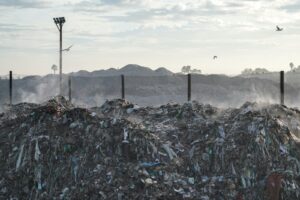London’s dirty air: how bad is it?
The cold, calm weather of the past few days has seen London and the south east experience very high levels of air pollution. Emissions from cars and wood burning stoves have seen levels of particulate matter soar to their highest concentrations since 2011.
We look at how scientists assess the scale of dirty air across the UK and the long term trends. And just how dangerous is the air that we breathe?
How do you measure air pollution?
There are air quality monitors dotted all across the UK – the major, government-run national network is called the Automatic Urban and Rural Network (AURN). Under the control of the Department of the Environment, Food and Rural Affairs, (Defra) it consists of 133 stations that automatically monitor a wide variety of pollution measures.
Local authorities also run networks of monitoring stations across the UK. In the capital, a key monitoring and forecasting network which works alongside local councils is London Air, run by King’s College London.
The scientists at King’s monitor pollution from over 100 measuring stations, in parks, back gardens and alongside major roads.
Observers believe that when it comes to the more accurate forecasting of conditions in London, the King’s network is more “on the spot” than the national system.
‘If you look at the forecast that Defra put out for Tuesday, they were only expecting a few patches of moderate level pollution across the country,’ said Andrea Lee, from Client Earth, which has brought a number of court cases on the question of air pollution.
‘This morning that had been revised and upped to “high”, but they are not picking up the very high levels that are being measured in London and in places like Norwich.’
The government air quality forecasts are produced by the Met Office, using a 1km x 1km grid system that some experts argue doesn’t give you the spatial accuracy that’s needed.
Those who run the King’s College network believe the differences come from the fact that many of their monitoring stations are focused on problem areas such as big roads.
‘The forecasts are done from different perspectives,’ said Gary Fuller from King’s College London.
‘The Met Office air pollution is forecasting air pollution very much in the way it forecasts the weather, it is intensely model-based. We are coming from the opposite end with less use of modelling and much more use of measurement.’
How does the UK rank when it comes to air pollution?
The current air pollution episode in London and the South East differs from the norm in the sense that the pollution mainly consists of high levels of particulate matter (PM). These tiny particles are coming from traffic and the burning of wood, while the windless weather means they have concentrated at high levels in several parts of the city.
While this is a short term problem that occurs in many other cities, where London and the UK fall down more often is on the question of nitrogen dioxide, (NO2), produced mainly by diesel cars.
In fact, so great are concentrations of NO2 in London that by January 5, Brixton had already exceeded the EU permitted amount for the whole year.
The UK has one of the highest rates of deaths linked to NO2, according to research from the European Environment Agency published last year.
The reason the UK is consistently in trouble on NO2 is because the government and the EU adopted the recommendations of the World Health Organization (WHO) on the safe level of exposure. Some argue these should be further tightened – and the WHO is starting to review the guidelines.
When it came to particulate matter, the government didn’t accept the WHO guidance, and set higher levels which the UK consistently comes in under.
But there is concern that many health problems linked to exposure to particulate matter may well be missed since the UK is consistently below EU levels.
‘We literally took the WHO evidence for NO2 and hence we have huge compliance problems,’ said Dr Fuller.
‘But we didn’t take them for PM2.5 and PM10. Even though we are meeting legal limits for these pollutants, they are causing a huge health burden – an estimated 29,000 early deaths each year in the UK. This illustrates the fact that our standards are relaxed compared to [those of the] WHO.’
Comparisons to other countries are difficult to make. Western European countries are more likely to have air pollution that comes from cars, while in Eastern Europe and other regions, the pollution comes from the use of different fuels.
‘People see images from China and India and say our pollution is nothing like that,” said Andrea Lee from Client Earth.
‘But the problem is that they are suffering from coal pollution which is very bad but very visible. The most you could probably notice is a bit of brown tinge over London, otherwise it’s so hard to see that most people are unaware of the harm that’s being caused.’
How much of a role does the weather play in air pollution?
Experts believe that the UK’s location on the western fringe of Europe is a major asset when it comes to eliminating air pollution, especially with particulate matter.
‘We do better on PM than many of the other European cities,’ said Dr Fuller.
‘We sit on the edge and normally the winds blow off the Atlantic so when it comes to the fresh air we are first in line, but when the air gets to Poland it’s passed over many kilometres of pollution sources.’
The absence of a breeze has made the current episode much worse but those in the field believe that focusing too much on the weather obscures the real problem.
Huge progress has been made in eliminating many air pollutants over the past 30 years. But efforts to limit and reduce NO2 have proved increasingly difficult.
‘If you look at NO2, we set limits in 1999 to be met by 2010. Here we are in 2017 with levels in places [that are] two or three times the legal limit,’ said Dr Fuller.
‘It’s not really a success story.’
Others say there is little doubt as to the cause of this persistent problem. It has been caused by the decision to encourage the purchase of diesel cars to reduce emissions of CO2 taken back in 2001.
‘The fact that it has happened here in the UK is a serious indictment of the UK government,’ said Jo Barnes from the University of the West of England.
‘The fact is that we really haven’t taken air pollution as seriously as necessary to do something about it. There’s more pressure on the government now, but whether they are actually doing anything is another matter.’














